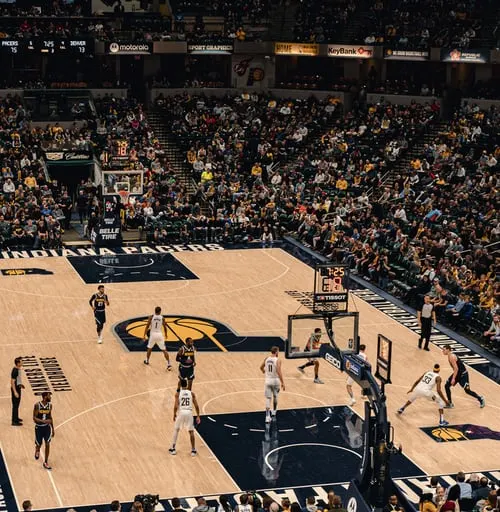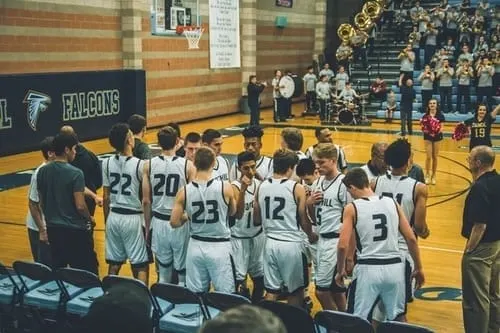The term reset in basketball is used in a variety of ways by the officials, coaches, and even the commentators in the NBA. Players will also reset during a game when it is necessary.
What does reset mean in basketball? The term reset is used in basketball in a number of ways, the most common is when a team on offense attempts to run a play but fails to, one of the players on the team will yell out reset. The ball is passed to the starting point of where the offense usually begins to reset the offense, to reset the shot clock or game clock, and is used by coaches to reset their player’s focus on the current basketball game that is not going well.
Game Reset is another term used that not many fans of the game know about, we will talk a little about each reset scenario and how in terms it affects the game. I guarantee you will learn something new.
If you are thinking about buying a basketball jersey or shoes, check out the offers below from these retailers.
| Retailer | Promo Code | Promotion | Link to Retailer |
 | DROP | 70% OFF | Go to Fanatics |
 | PARSCR20 | 20% OFF | Go to Eastbay |
 | N/A | N/A | Go to Amazon |
Reset the Offense
Often times coaches will run set plays in a basketball game that fail to materialize.
It is up to the players to recognize this and not force up shots for the sake of the offense.
Smart players will reset, this allows the team to either run the same play again or a totally different one.
This will depend on how much time is left on the shot clock when the first play failed.
If there is not enough time on the clock and the player resets the play this will force the player with the basketball to go one on one with their defender.
Resetting the offense allows a team to get a better look at the basket without forcing up a shot.
Your initial offensive set didn’t work so you reset to run a different play hoping the defense is tired while you get a better look.
At the start of the shot clock, the defense will be at its strongest but as time runs down on the shot clock the D may start to get tired and an opportunity may present itself.
You may also see something in the defense that may be a weakness in which you want to attack.
Sometimes teams will reset realizing that the defense has now switched to a zone and a regular offense would not work during the zone, therefore they would reset and run their offensive zone plays against that particular zone.

Reset of the shot clock
The shot clock in basketball is the number of seconds a team has to take a shot at the basket.
In each level of play from high school to professional, the rules of the shot clock are different when it comes to the number of seconds a team has to shoot the basketball.
Depending on what level of basketball your playing, if the shot is taken and the defense rebounds the ball.
The shot clock resets to a fresh 24 seconds in the NBA and 30 seconds in the NCAA.
If you take a look at the chart below, each league has a number of seconds for a team to shoot the basketball to prevent violation and turnover of the ball.
| League | Shot Clock in Seconds |
| High School | 30 to 35 Depending on State |
| NCAA | 30 Seconds |
| FIBA | 24 Seconds |
| NBA | 24 Seconds |
Reset of the shot Clock on Offensive Rebound
Reset in basketball can also mean the shot clock is reset after an offensive rebound, after every shot that is taken in basketball the shot clock is reset even on offensive rebounds just not to the full shot clock that you had on turnover of possession.
Each league again is different when taking possession of the ball for second-chance points, usually meaning much less time to shoot the basketball as the shot clock is shorter in time.
This could mean 30 to 35 seconds playing in high school, and now 20 Seconds playing in the NCAA, and 14 seconds in the NBA. Here’s the breakdown.
| League | 2nd Attempt Shot Clock Reset |
| High School | 30 to 35 Seonds |
| NCAA | 20 Seconds |
| FIBA | 14 Seconds |
| NBA | 14 Seconds |
FIBA was actually the first to implement the shot clock reset of 14 seconds on second-chance points in 2014.
The NBA soon followed in 2018. In these 3 scenarios, you will see the shot clock reset in the NBA and FIBA.
- After an offensive rebound on a shot attempt or a missed field goal.
- After a loose ball foul that followed a missed field goal or free throw that hit the rim. (Basically, the two scenarios happening at the same time).
- When the team on offense gets possession of the basketball after a missed field goal or free throw that goes off the defense and is out of bounds.
The NCAA as of 2019 also made a rule change, you may not have heard of it because we were in the middle of a pandemic (Covid-19) that involved the cancellation of the College Basketball season.
The NCAA now has changed their shot clock reset on second opportunities to 20 seconds.
I really like this idea on second-chance attempts of resetting the shot clock as this speeds up the game of basketball, provides higher scoring games, and creates a lot more exciting action.
The rules before had players running down a full shot clock waiting at the top of the key after an offensive rebound to 10 to 12 seconds and then shooting.
They did this because they were allowing their own team to reset and catch their breath.
The Game Reset

Reset the Mindset
As a basketball coach myself, oftentimes I would call a timeout in the first quarter of play due to how my team is playing.
Players are nervous in a big game, scared to make mistakes in fear of being subbed out, and even blaming each other on the court for not picking up their man.
What makes it even worse is when the referees get to the players and they can’t get a call.
They are frustrated at how the game is playing out. Sometimes even taking themselves mentally out of the game.
These are perfect opportunities to take a timeout sometimes even a double timeout and talk some sense into the players.
Usually, the talk is about not focusing on the negatives but trying to focus on the positives.
I like to also give small goals to achieve in the game, if we are down 15 points with 3 minutes left in the second quarter, I will call the time out and encourage our players to get the lead down to single digits by half time.
Resetting the player’s mind can happen in many forms, but it is especially important to get their attention before the game is out of reach and is too late.
